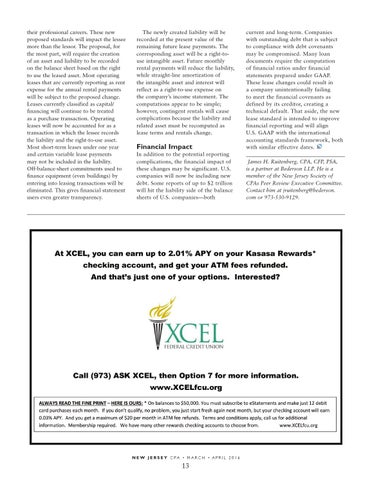their professional careers. These new proposed standards will impact the lessee more than the lessor. The proposal, for the most part, will require the creation of an asset and liability to be recorded on the balance sheet based on the right to use the leased asset. Most operating leases that are currently reporting as rent expense for the annual rental payments will be subject to the proposed change. Leases currently classified as capital/ financing will continue to be treated as a purchase transaction. Operating leases will now be accounted for as a transaction in which the lessee records the liability and the right-to-use asset. Most short-term leases under one year and certain variable lease payments may not be included in the liability. Off-balance-sheet commitments used to finance equipment (even buildings) by entering into leasing transactions will be eliminated. This gives financial statement users even greater transparency.
The newly created liability will be recorded at the present value of the remaining future lease payments. The corresponding asset will be a right-touse intangible asset. Future monthly rental payments will reduce the liability, while straight-line amortization of the intangible asset and interest will reflect as a right-to-use expense on the company’s income statement. The computations appear to be simple; however, contingent rentals will cause complications because the liability and related asset must be recomputed as lease terms and rentals change.
Financial Impact
current and long-term. Companies with outstanding debt that is subject to compliance with debt covenants may be compromised. Many loan documents require the computation of financial ratios under financial statements prepared under GAAP. These lease changes could result in a company unintentionally failing to meet the financial covenants as defined by its creditor, creating a technical default. That aside, the new lease standard is intended to improve financial reporting and will align U.S. GAAP with the international accounting standards framework, both with similar effective dates.
In addition to the potential reporting complications, the financial impact of these changes may be significant. U.S. companies will now be including new debt. Some reports of up to $2 trillion will hit the liability side of the balance sheets of U.S. companies—both
James H. Ruitenberg, CPA, CFP, PSA, is a partner at Bederson LLP. He is a member of the New Jersey Society of CPAs Peer Review Executive Committee. Contact him at jruitenberg@bederson. com or 973-530-9129.
NEW JERSEY CPA • MARCH • APRIL 2016
13
